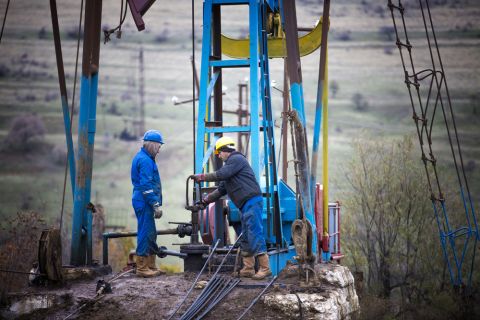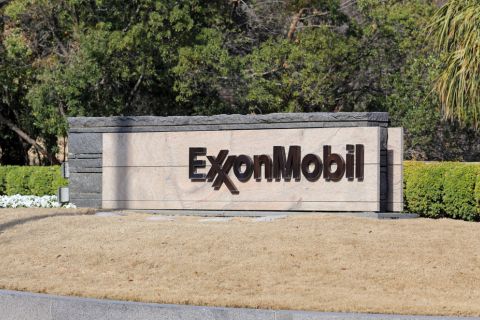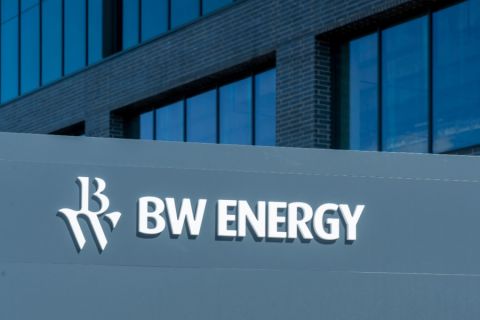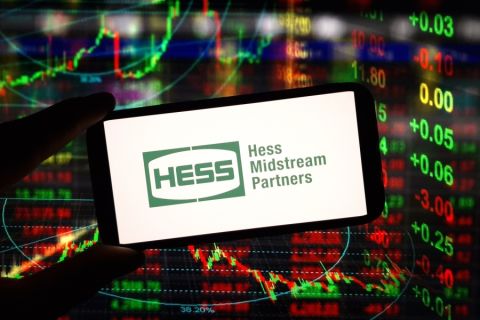 |
| ?“It was a chance to work on assets that I knew had a tremendous amount of remaining potential.” -Tim Parker, HighMount Exploration & Production |
W?hen Tim Parker graduated from Stanford University with two geology degrees, he considered continuing his academic pursuits for a doctorate degree but decided to take a few years off to join the oil industry—the first in his family to do so.
Starting his career “not by mistake, but not by design either,” he began as a prospecting geologist in the Rockies for an E&P subsidiary of Santa Fe Railroad. By the time Santa Fe Snyder Oil Corp. was bought by Devon Energy Corp. in 2000, Parker was involved in all aspects of E&P management. Following the deal, he was asked to join Dominion Resources Inc. in New Orleans to run its offshore program.
After a year in the Big Easy, Parker moved to the Houston office and became chief operating officer of Dominion Resources and senior vice president, E&P, for Dominion Exploration & Production.
Dominion Corp., the parent, eventually decided to divest all its E&P assets except in Appalachia, and Parker was tapped to lead a new E&P subsidiary of New York conglomerate Loews Corp. named HighMount Exploration & Production LLC, which bought Dominion’s Permian Basin, Michigan Antrim shale and Alabama Black Warrior Basin assets in 2007 for $4 billion. Included were some 2.5 trillion cubic feet equivalent of reserves.
He launched HighMount that July with plenty of reserves and acreage, but about 100 people short of the talent base needed, as some future employees were still tied up with Dominion. With these problems now behind the company, Parker has enjoyed his position as chief executive and president, where his background in geology is allowing him to help create a prosperous and well-focused company with a well-established team.
Parker visited with Oil and Gas Investor about some of the challenges of the start-up, his goals for its operations and his industry experiences.
Investor What were some of the key projects you worked on while you were at Dominion?
Parker Certainly some of the highlights were offshore, where I worked on Devil’s Tower and Independence Hub, and many projects onshore were exciting, such as our work in the Midcontinent and the Uintah Basin. One of the joys of Dominion was the breadth and scope of the enterprises we constructed.
Investor What drew you to the Loews E&P venture?
Parker It was a chance to continue working with a great group of people I enjoyed very much. It was a chance to work on assets that I knew had a tremendous amount of remaining potential. And it was a chance to take those skills and the assets we had in place and see if we could grow something new, bigger, different and better.
Investor How has the transition been?
Parker The transition was occasionally difficult. Many of the people who were going to eventually work for HighMount had to remain with Dominion while it concluded its accounting and administrative work on the rest of the packages it was divesting. So, not all of HighMount’s personnel was with us at the very beginning.
At the same time, we knew we had to hire more staff and grow an entirely new infrastructure for the company. We switched computer-based accounting systems. We had to build an entirely new communications structure, while at the same time we had to maintain the quality and depth of our operations on the assets that were going to become part of HighMount.
That was a huge challenge and I’m incredibly proud that our people rose to the occasion and delivered the goods every day. Some of the things experts told us we couldn’t do, we did.
Investor What is HighMount doing differently with Dominion’s Permian Basin assets?
Parker Well, some of it is a continuation of efforts we had already started. For instance, we are big believers in electronic data capture. Sonora Field is one of the largest applications of electronic flow-meters around. That is a continuation of what we did at Dominion. Meanwhile, we’ve slowed our drilling pace down a little. You may find it hard to believe that we’ve slowed down when we’ll drill more than 380 wells this year. That’s allowed us to spend a little bit more time and be more selective with our well choices. We’ve been well rewarded with this tack this year.
e’re spending more time worrying about surface issues than we have in the past. One of my prejudices is that, if you looked around the industry overall, it has invested too little between the wellhead and the sales point. So one of the things we’re doing with Sonora and other areas is we’re really taking a look at ways we can enhance production and profitability by investing in surface facilities.
We’re drilling a little bit deeper on more of our wells.
Investor How is the Antrim shale doing in this shale-crazy environment?
Parker The Antrim is sort of the dependable member of the shale family. It just continues to go along. There’s nothing that has happened that is extraordinarily positive with the Antrim, although we were always looking for new things. It just continues to go along and make money.
It’s important to remember where it is in its life. The play dates from the early 1990s, and much of its life was tax-credit driven. As a result, you get things that are much different out of 20-year-old plays than you do out of brand new ones.
Investor You said you will drill 380 wells by year-end. Will you be considering acquisitions also?
Parker If we can find the right way to grow for the benefit of our parent and our shareholders, then yes, we are interested in acquisitions.?We believe there will be some and we will be a very active participant in those acquisitions.
Investor How does being a subsidiary of Loews affect your operations?
Parker In some ways, not at all. In some ways, it changes the way we think about our business. We used to be a subsidiary of Dominion, so we’ve always had a parent relationship. But there are aspects that are completely different. For instance, some of our IT functions used to be managed and controlled at headquarters in Richmond, Virginia. That’s no longer the case. We’re responsible for all of that. We have to be sure we meet Loews’ corporate standards, but it’s mostly our decision now.
In the field, one of the strengths of a Loews management team is that they recognize that we’re paid to appropriately run these assets. They recognize that there are some issues that they want to have a complete understanding of, and there are other decisions, like mechanical decisions, they feel are properly left to us. It’s a very strong model and something we’ve settled into very well. We’ve worked our way through what we need to talk about and when, and my co-workers and I have been pleased to be part of the Loews family.
Investor How has the experience of running HighMount been so far?
Parker This is a different company, and our needs and plans are different than Dominion’s were, so from that perspective it’s been different. It’s been fascinating and it’s been fun, and some of the reasons I came over here have worked out exactly right. I’ve been overjoyed to work with the people I work with. I am proud of them and the work we do. And I’m excited about our future.
Investor What are some challenges?
Parker At this point it’s three areas. It’s staffing, as this is certainly a very challenging time in the industry to attract people to your company and into the industry. Then there’s opportunity capture. We’re certainly dealing with a heated competitive environment out there, and finding ways to compete where you add value, rather than destroy it, is a challenge every day.
The third issue is the increasingly inflationary environment in which we’re operating and trying to find equipment. You’ll find that there’s a lot of sleep being lost by a lot of people over steel these days. Where are you going to find tubulars and at what cost?
Investor What has HighMount been doing to attract new employees?
Parker The place where we’ve had the hardest time is going onto university campuses. We are committed to having an active intern program and hiring right out of school for engineers and geoscientists. We’ve had a very difficult time building our profile on campuses. We think we’ll do better this year than the first year, but it has been a challenge so far.
Recommended Reading
Dividends Declared in the Week of May 6
2024-05-10 - Here is a selection of upstream, midstream and service and supply companies’ dividends declared in the past week.
OFS Sector Loses Jobs, but Trade Org Says Growth Potential Remains
2024-05-08 - According to analysis by the Energy Workforce & Technology Council, the OFS job market may still have potential for growth despite a slight decrease in the sector in April.
Exxon Appoints Maria Jelescu Dreyfus to Board
2024-05-08 - Dreyfus is CEO and founder of Ardinall Investment Management, a sustainable investment firm, and currently serves on the board of Cadiz Inc. and Canada-based pension fund CDPQ.
E&P BW Energy Undergoes ‘Technical’ Ownership Restructuring
2024-05-08 - The restructuring will not involve any change to the ultimate control of BW Energy as the shares currently held by BW Group will be sold to BW Energy Holdings.
Hess Midstream Subsidiary Plans Private Offering of Senior Notes
2024-05-08 - The proposed issuance is not expected to have a meaningful impact on Hess Midstream’s leverage and credit profile, according to Fitch Ratings.





